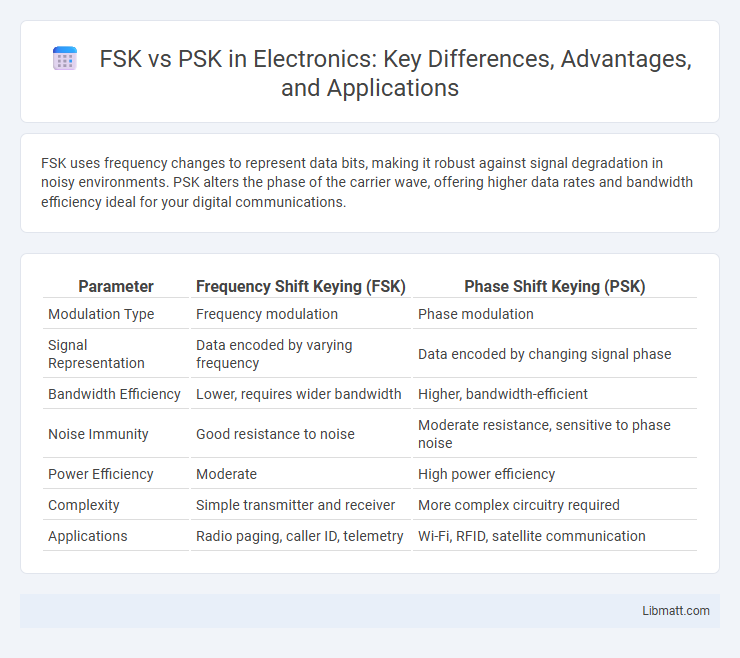FSK uses frequency changes to represent data bits, making it robust against signal degradation in noisy environments. PSK alters the phase of the carrier wave, offering higher data rates and bandwidth efficiency ideal for your digital communications.
Table of Comparison
| Parameter | Frequency Shift Keying (FSK) | Phase Shift Keying (PSK) |
|---|---|---|
| Modulation Type | Frequency modulation | Phase modulation |
| Signal Representation | Data encoded by varying frequency | Data encoded by changing signal phase |
| Bandwidth Efficiency | Lower, requires wider bandwidth | Higher, bandwidth-efficient |
| Noise Immunity | Good resistance to noise | Moderate resistance, sensitive to phase noise |
| Power Efficiency | Moderate | High power efficiency |
| Complexity | Simple transmitter and receiver | More complex circuitry required |
| Applications | Radio paging, caller ID, telemetry | Wi-Fi, RFID, satellite communication |
Introduction to FSK and PSK
Frequency Shift Keying (FSK) and Phase Shift Keying (PSK) are essential digital modulation techniques used in wireless communication systems. FSK represents data by varying the carrier frequency, while PSK encodes information through changes in the carrier signal's phase. Both methods provide robust signal detection and efficient bandwidth usage, making them fundamental in applications like radio transmission and digital data communication.
Fundamental Concepts of FSK
Frequency Shift Keying (FSK) is a digital modulation technique where data is transmitted by varying the frequency of a carrier signal between discrete values representing binary states. FSK involves two primary frequencies: one frequency for a binary '1' and another for a binary '0', enabling reliable signaling over noisy communication channels. This modulation method excels in applications requiring robustness against signal degradation and is widely used in radio transmission and modem communications.
Fundamental Concepts of PSK
Phase Shift Keying (PSK) is a digital modulation technique where the phase of a carrier signal is varied to represent data bits, offering efficient bandwidth usage and improved noise immunity compared to Frequency Shift Keying (FSK). PSK modulates the phase of the sinusoidal waveform at discrete intervals, allowing multiple bits per symbol in higher-order schemes such as QPSK and 8-PSK, enhancing data rates. The fundamental concept revolves around encoding information into phase shifts, making PSK highly effective for high-speed communication systems requiring robust performance in noisy environments.
Key Differences Between FSK and PSK
FSK (Frequency Shift Keying) modulates data by shifting the carrier frequency between discrete values, while PSK (Phase Shift Keying) changes the phase of the carrier wave to represent data. FSK is more resilient to noise and interference, making it suitable for low-bandwidth communication, whereas PSK offers higher spectral efficiency and better performance in high-noise environments. The primary distinction lies in their modulation parameters: FSK varies frequency, while PSK varies phase, affecting complexity, bandwidth usage, and error rates.
Advantages of FSK
Frequency Shift Keying (FSK) offers superior noise immunity compared to Phase Shift Keying (PSK), making it ideal for environments with high interference. FSK signals are less susceptible to errors caused by signal degradation, enhancing communication reliability. Your data transmission benefits through simpler receiver designs and stable performance in non-line-of-sight and fading channels.
Advantages of PSK
PSK (Phase Shift Keying) offers higher bandwidth efficiency compared to FSK (Frequency Shift Keying) by transmitting data at multiple phase angles, enabling faster data rates within limited spectrum. PSK demonstrates greater resistance to signal degradation and noise, resulting in improved reliability and lower bit error rates in digital communication systems. The implementation complexity of PSK can be lower in modern coherent receivers, facilitating advanced modulation schemes like QPSK and 8-PSK for enhanced spectral efficiency.
Applications of FSK in Modern Communication
Frequency Shift Keying (FSK) is widely used in modern communication systems such as radio transmitters, RFID, and caller ID telephony due to its robustness against noise and signal fading. Applications like low-frequency radio communication and telemetry capitalize on FSK's ability to provide reliable data transmission over long distances. Your wireless network devices benefit from FSK modulation techniques that ensure stable connections in various environmental conditions.
Applications of PSK in Modern Communication
PSK (Phase Shift Keying) is widely used in modern communication systems such as Wi-Fi, RFID, and satellite transmissions due to its efficient bandwidth utilization and robustness against noise. Digital platforms like Bluetooth and LTE employ PSK variants including BPSK and QPSK for reliable data transfer and enhanced spectral efficiency. Compared to FSK (Frequency Shift Keying), PSK provides higher data rates and better error performance, making it ideal for high-speed, secure wireless communication.
Performance Comparison: FSK vs PSK
Frequency Shift Keying (FSK) typically offers better noise immunity than Phase Shift Keying (PSK), making FSK more reliable in environments with signal fading and interference. PSK, particularly higher-order schemes like QPSK and 8-PSK, provides superior spectral efficiency and higher data rates, beneficial for bandwidth-limited applications. However, PSK requires higher signal-to-noise ratios (SNR) for error-free performance, while FSK's robustness comes at the cost of lower data throughput.
Choosing the Right Modulation: FSK or PSK
Choosing between FSK (Frequency Shift Keying) and PSK (Phase Shift Keying) depends on your communication system's requirements such as noise tolerance, bandwidth efficiency, and power consumption. FSK is more robust in noisy environments due to its frequency separation, making it ideal for low-speed, long-distance transmissions. PSK offers better spectral efficiency and higher data rates, suited for bandwidth-limited channels where maintaining signal integrity is critical.
FSK vs PSK Infographic

 libmatt.com
libmatt.com